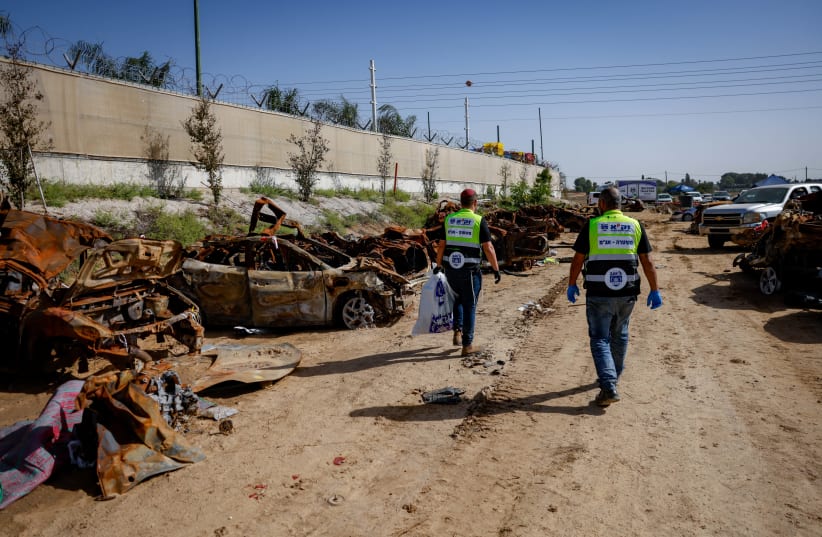Heroes everywhere.
During our nation’s war against evil, heroes have emerged from every sector of our population. Soldiers, reservists, first responders of October 7, wives of soldiers, volunteers from across the world, and simple people of faith.
Among all these brave warriors, one quiet group of heroes stands out. Those who attended to the slain victims of this massacre, who endangered their lives as well as their mental well-being in providing honor to those from whom it was so violently taken.
As the horrific images so brutally demonstrated, many victims were badly mutilated and, in some cases, burnt beyond recognition. The silent and strong heroes who identified and buried the victims afforded one final semblance of dignity to the dehumanized bodies which had once cradled human souls.
The silent courage of these heroes showcased how deeply we value the dignity of a human body even after life has departed from it. Showing final respect and honoring the dead is deeply rooted in the ethics of Torah and in our life-revering culture.
The mysterious Jewish death ceremony of egla arufa
The mysterious ceremony of egla arufa typifies the care and dignity we afford the dead. If a dead and unattended-to body is discovered, it isn’t quietly buried. Instead, the public ceremony of egla arufa is conducted, which includes confessionals by the leaders of the local towns. Leaders of nearby villages are held “accountable” because a person died on their watch, even though they were not directly culpable for the death. Tragic death cannot simply be ignored.
You would think that an anonymous John Doe discovered in a barren field would not warrant a public response. Typically, unidentified bodies belong to people who inhabit the margins of society. When established members of society go missing, family members and neighborhood friends conduct a search. Presumably, the unidentified corpse described in the Torah is a homeless person without much family, who has long ago fallen off the social radar.
However, it is precisely when the dignity of human life is most vulnerable that it must be strongly reinforced. Specifically at this moment, when life can be easily taken for granted, the shared sanctity of every human being must be underscored. The public ceremony of egla arufa demonstrates that every human being is created equal in the eyes of God, and each possesses divine dignity. By burying the unidentified corpse, we honor the imprint of God within each human being.
Surprisingly, the Midrash asserts that Joseph, in his first correspondence to his father, alluded to the egla arufa ceremony, reminding Jacob that decades earlier, they had jointly studied this topic. Evidently, Joseph’s referencing of egla arufa delivered an important message to his father. Though initially Joseph was ripped from his family and sold into slavery, he had emerged as the second-most powerful man on Earth and was singlehandedly steering a hungry world through an nightmarish famine. Joseph’s prescient wisdom and tireless dedication saved millions of lives. By preserving life and protecting human dignity, Joseph was, in effect, implementing the doctrines of egla arufa.
October 7: How Hamas violated the dignity of the dead
The vicious assault of October 7 included numerous acts of horror and barbaric indecency. One of the most repulsive aspects of this massacre was the manner in which human bodies were treated. As if torturing and murdering in cold blood weren’t sufficiently nauseating, the terrorists mutilated and dismembered lifeless bodies. Pure and unadulterated evil, destruction, and violence for absolutely no purpose. Their grotesque crimes demonstrated how little they regard human dignity and how cheap life is in the eyes of Islamic terrorists.
Their dehumanizing crimes made our own response and our own gentle treatment of dead bodies even more critical. Our silent heroes, which include soldiers, ZAKA volunteers, and countless others who spent weeks identifying and burying victims, solemnly restored dignity to those who had been twice victimized – in life and in death.
In providing this honor, many subjected themselves to hideous sights and unforgettable images that will forever mar their inner conscience. These heroes of human dignity paid a steep price in their sacred calling of providing honor to those beyond the veil of life. In many instances they operated under fire, risking their lives to restore dignity to lifeless bodies.
This quiet heroism underscores the clash of ideologies within this military war: A battle is being waged between a culture of death and a culture of human dignity. Between a culture which cheapens human life and one which treasures it. Our war isn’t merely a military encounter but a clash of cultures between competing value systems.
Though these murderers speak in the name of religion, they are nothing more than brutish atheists masquerading as religious people. They describe a god who doesn’t exist. Denying the traits of God is tantamount to denying His presence.
We believe that all-powerful God lovingly created Man and endowed him with divine traits of free will, consciousness, and creativity. Our respect for every human being acknowledges Man as the masterpiece of creation. We respect this divine masterpiece even when life has departed from it. God’s divine image isn’t limited to our souls but to the bodies which once cradled divine essence.
By defiling human bodies, these charlatans scorn any notion of tzelem elokim. These violent beasts fictionalize about a god of bloodlust and of anger, not one of compassion and mercy. By mutilating dead bodies, they mutilate the image of God in our world.
By mocking human dignity, these violent murderers haven’t just committed a grave theological sin but have also doomed themselves and their cultures to failure and futility. Belief in human dignity isn’t just a religious value but powers human achievement and human progress. Through our God-given creativity, we believe that we are empowered to improve our world and redeem it for mankind.
If God is compassionate, He desires human prosperity. If God covets well-being, we must be His agents to advance and improve our world. Prolonged human suffering isn’t consistent with a merciful God who crafted human beings in His image. A culture that reveres human dignity is religiously driven to improve and advance the human condition.
A culture with no concern for human dignity provides little incentive for change, growth, or progress. When life is cheap, suffering is acceptable. When suffering is acceptable, progress is stunted. By mutilating bodies, these barbarians don’t just disfigure God, they maim their own society and dismember themselves of any real progress or advancement.
It is tragic but ironic that terrorists spent billions of dollars building machineries of death. Terror tunnels have absolutely no ulterior purpose or function other than havoc and death. Instead of investing in human beings, these bloodthirsty terrorists invested in death. How much potential and how much human capital was completely wasted in the pursuit of blood and revenge? How many lives could have been improved had those funds been spent on life rather than on death?
Our battle continues. They viciously defile life, and we gently protect it. They dehumanize, and we revere. They holler over corpses, while we honor the stillness of the departed. They will sink into their own tunnels of hatred while we build towers of achievement.
There is only one winner in this clash of cultures.
The writer is a rabbi at Yeshivat Har Etzion/Gush, a hesder yeshiva. He has smicha and a BA in computer science from Yeshiva University, as well as a master’s degree in English literature from the City University of New York.

